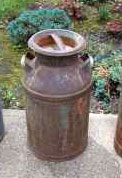Back in the 1930's and 1940's many farmers in the Minonk area had dairy cattle to supplement their income and to provide dairy products for their own consumption. That was the good side. The bad side was that it was hard work to raise dairy cattle. Many farmers milked cows by hand morning and night. I remember at family gatherings on a Sunday afternoon when a farmer would have to leave the gathering early in order to get back home to milk the cows.
Back then there were not as many health regulations. I would often be with my Uncle Bill VonBehren at milking time. After herding the cows into their stalls, he would fasten them in a stanchion, which was a device that held the cows head in place so it wouldn't move. Then he would put clamps on the rear legs to prevent the bovine monsters from kicking the milk pail or the milker. Getting a cow situated could be a formidable task. Sometimes a cow would step on the farmer's foot causing him to hobble around for a few days.
The last thing before milking commenced was to spray the cow with either malathion or DDT, both which were powerful insecticides, to keep the flies away.
Evidently, flies were more of a concern than the use of insecticides around milk. Since then DDT has been banned and malathion is suspected of being carcinogenic.
The cows were usually given ear corn and some hay while milking to keep them occupied while being milked in addition to providing them their feed. The sound of a cow chewing an ear of corn sounded like a grinding machine or corn sheller. Their teeth must have been as hard as diamonds. I never understood how cows could get nutrients from an ear of corn. The corn kernel is swallowed whole by the cow and when you examine a cow patty, the corn kernels are still intact.
While milking you have to be aware of unexpected happenings. Once in awhile a cow will decide to have a bowl movement in which case, one must gather the milk bucket and clear out of the way until nature has finished its course. Whenever the cow raises its tail, its time to grab the milk pail.
The farm cats would congregate in the barn at milking time to drink milk that Uncle Bill would pour into their bowls. This was before veterinarians told us that milk wasn't good for cats. Once in a while, he would squirt milk from the cow's teat to see if he could hit a cat.
In the evening milk time, Uncle Bill's little neighbor boy, Harold Lindley, would walk a half mile from his farm to Uncle Bill's barn to listen to the baseball scores on the radio which sat on a platform nailed to the barn wall. Occasionally, a cow would kick over the milk pail and Uncle Bill, who normally was a quiet, reserved person, would cuss a blue streak at the cow. Similar words were uttered whenever a cow's tail would swish across his face. Remember, a cow's tail is unlike the fine fur of a cat's tail. The tail hairs are usually coarse and crusty with manure and can scratch a face. Some farmers would tie the cow's tail up to prevent being slapped.
 The final step in the milking process is to pour the milk through a strainer into the milk can. During the summer the milk can was placed in the cattle's water tank to keep the milk cool. Every other day the milkman would pick up the milk can and leave a clean one to be filled. Milkmen were known for their strength and the number of hernias they had. A full 10 gallon milk can weighed almost 100 pounds.
To get the milk can 2 feet up into the back of the milk truck, the milkman would swing the can with a mighty heave and then drop the can at the top of the swing arc onto the truck bed. This was before they had hydraulic lifts for loading.
The final step in the milking process is to pour the milk through a strainer into the milk can. During the summer the milk can was placed in the cattle's water tank to keep the milk cool. Every other day the milkman would pick up the milk can and leave a clean one to be filled. Milkmen were known for their strength and the number of hernias they had. A full 10 gallon milk can weighed almost 100 pounds.
To get the milk can 2 feet up into the back of the milk truck, the milkman would swing the can with a mighty heave and then drop the can at the top of the swing arc onto the truck bed. This was before they had hydraulic lifts for loading.
Some of the milk was kept for personal consumption. The milk would be run through a separator which would separate the milk from the cream. Sometimes the milk was drunk straight from the cow. I doubt if anyone today could stomach drinking milk that had strings of cream in it but I can remember how good it tasted. No 2% milk in those days. Milk straight from the cow was 100 proof and probably wouldn't pass the FDA regulations of today.
Besides providing milk, a cow's slow and quiet demeanor gave a sense of calmness to the farmstead. In addition, they provided practical solutions such as when we would use the cow's dried manure patties as bases when playing baseball in the pasture. Occasionally, as a little boy I would lick their salt blocks until my mother would see me and chase me out of the pasture.
Those of us who survived the lack of government regulations on milk production are none the less for wear and have many happy memories of milking time.